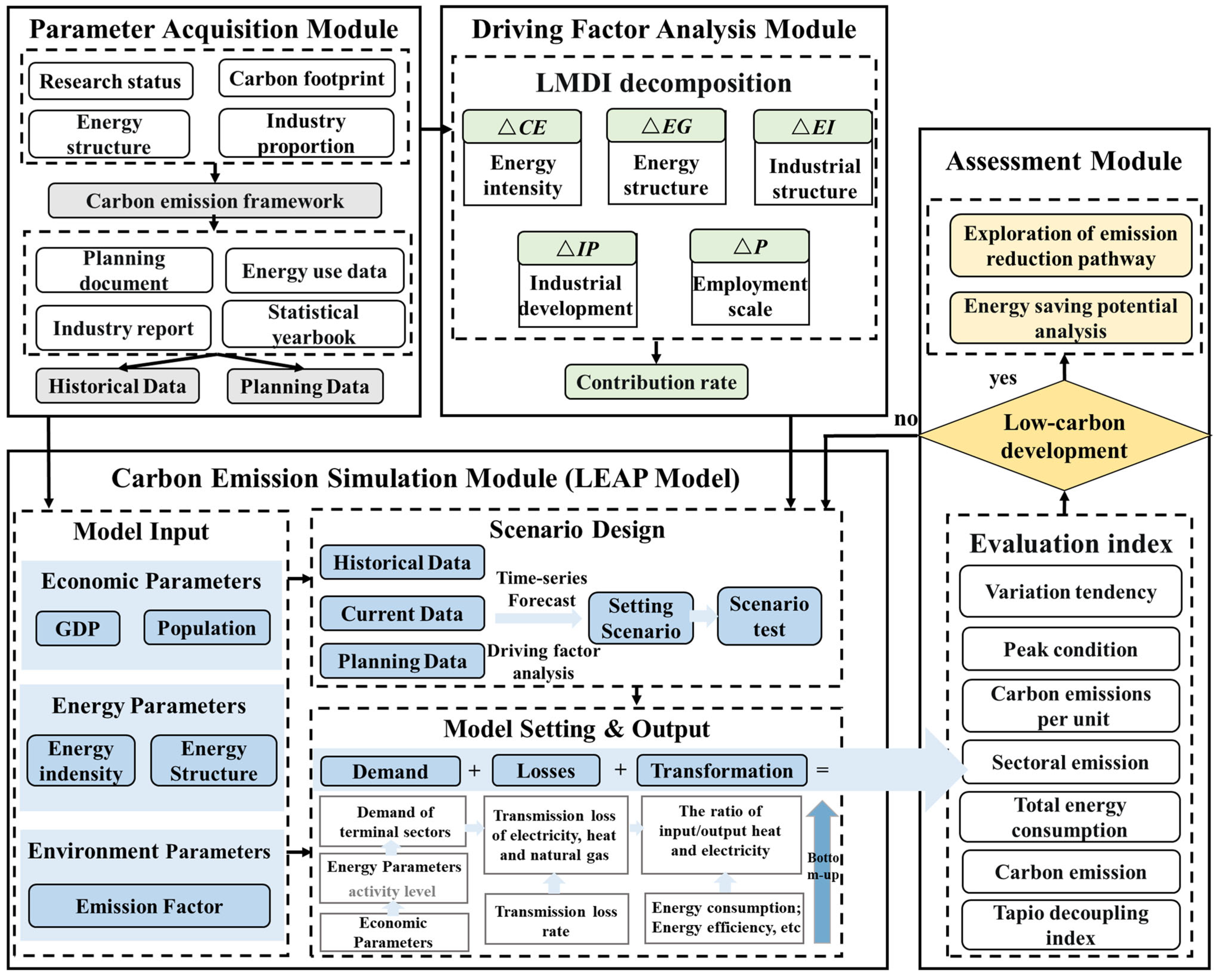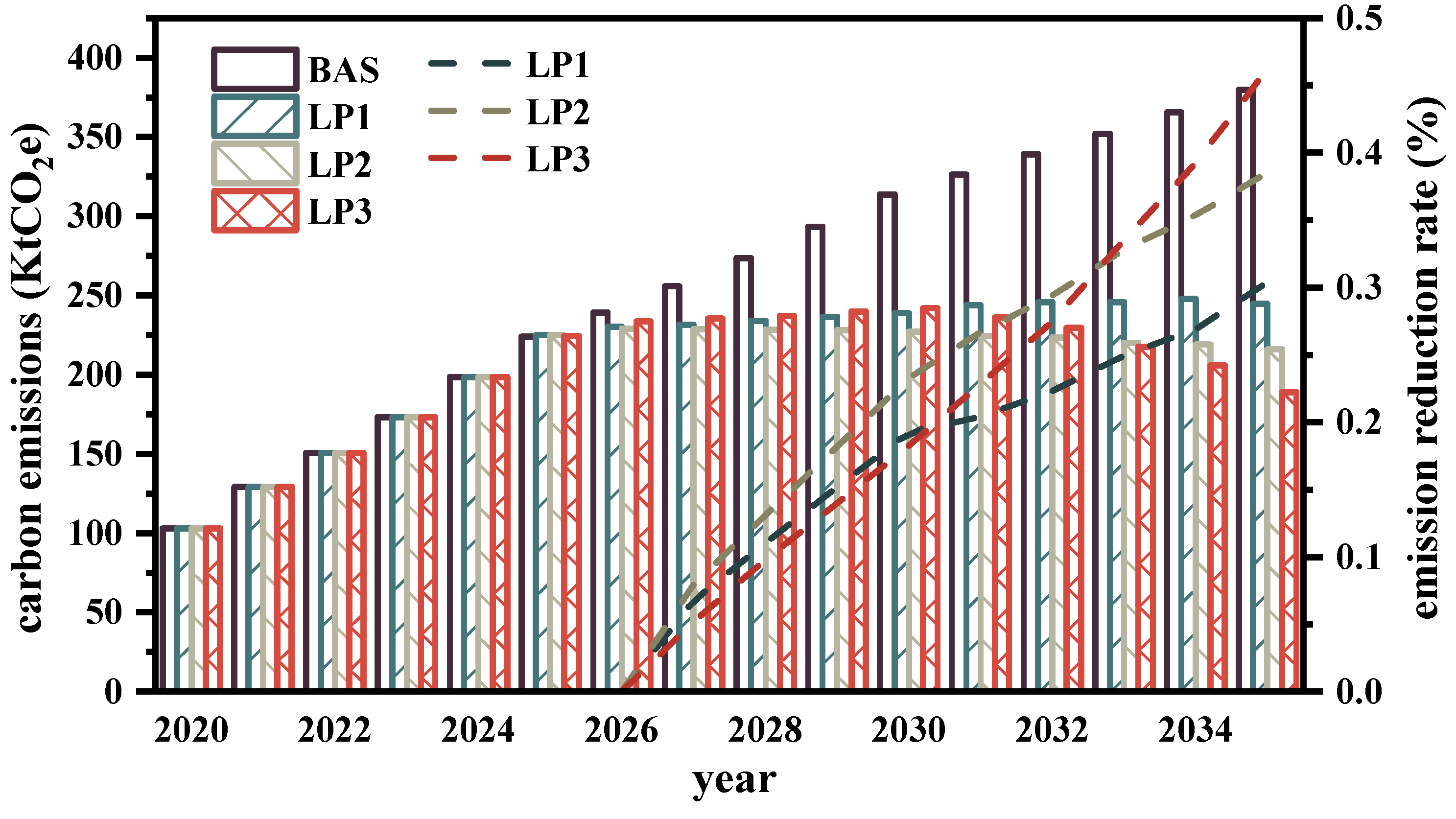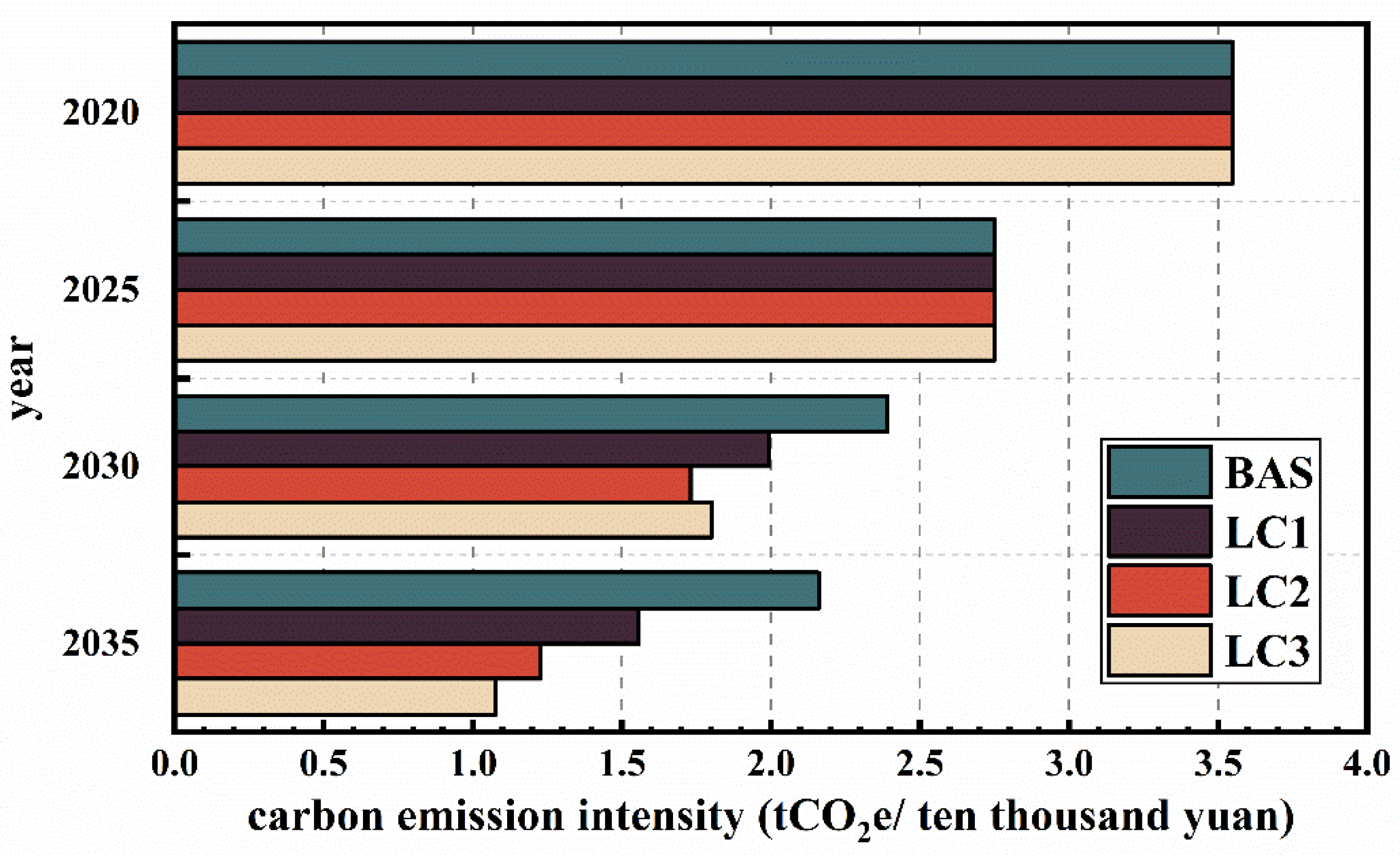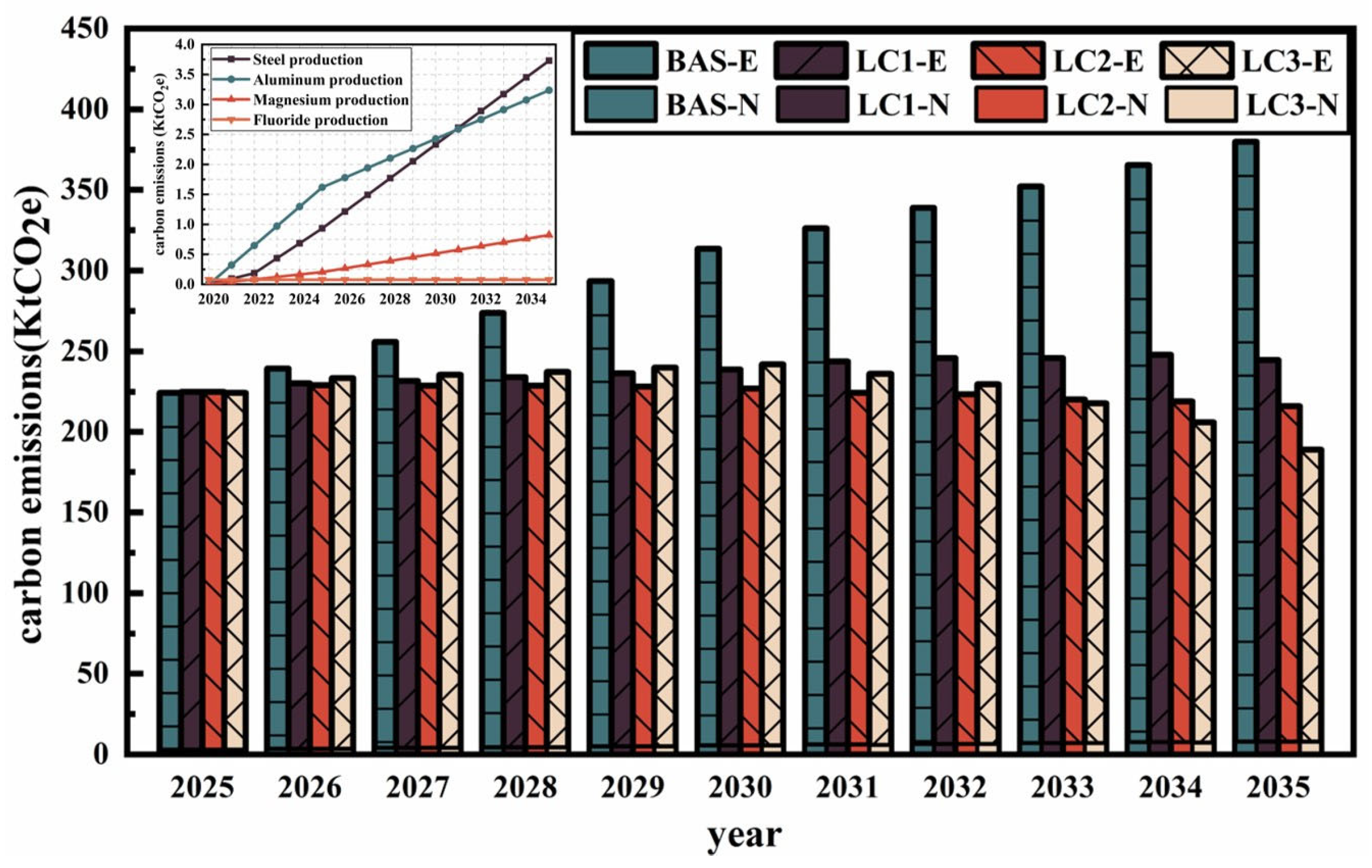Carbon Emission Prediction and the Reduction Pathway in Industrial Parks: A Scenario Analysis Based on the Integration of the LEAP Model with LMDI Decomposition
Abstract
:1. Introduction
2. Methodology
2.1. Analysis Framework
2.2. LEAP Model
2.3. Decomposition Model
2.4. Tapio Decoupling Theory
2.5. Data Sources
3. Model Analysis and Scenario Setting
3.1. Analysis of Driving Factors
3.2. Scenario Setting
3.3. Decoupling Analysis
4. Discussion
4.1. Total Carbon Emissions under Different Scenarios
4.2. Carbon Emission Source Analysis
4.3. Pathways for Low-Carbon Industrial Park Development
5. Conclusions
- In accordance with the characteristics of the industrial park, the driving factors can be categorized as follows: energy intensity, energy structure, industrial structure, industrial economic development, and employment scale. Among these factors, industrial economic development accounts for 52%, indicating that the park has not achieved decoupling in the initial stage of development and remains highly dependent on the economy.
- Under the BAS scenario, carbon emissions will reach 351.4 KtCO2e by 2035. However, the carbon emissions of the LC1, LC2, and LC3 scenarios decrease by 30.4%, 38.4%, and 46.2%, respectively, compared to the BAS scenario. Among these scenarios, the LC3 scenario emerges as the most suitable pathway for reducing emissions in the park.
- Additionally, investment in emission reduction technology; an increased proportion of clean energy; measures aimed at reducing carbon emissions from coal, such as improving the efficiency of terminal energy devices; optimizing process flows; and introducing carbon capture devices, are crucial for controlling total emissions and achieving sustainable emission reduction in the park.
Author Contributions
Funding
Data Availability Statement
Conflicts of Interest
References
- Giama, E.; Kyriaki, E.; Papaevaggelou, A.; Papadopoulos, A. Energy and Environmental Analysis of Renewable Energy Systems Focused on Biomass Technologies for Residential Applications: The Life Cycle Energy Analysis Approach. Energies 2023, 16, 4433. [Google Scholar] [CrossRef]
- Gao, X.; Wei, P.; Yu, J.; Huang, X.; Yang, X.; Sundén, B. Design and assessments on graded metal foam in heat storage tank: An experimental and numerical study. Int. Commun. Heat Mass Transf. 2023, 146, 106902. [Google Scholar] [CrossRef]
- Li, Y.; Huang, X.; Huang, X.; Gao, X.; Hu, R.; Yang, X.; He, Y.L. Machine learning and multilayer perceptron enhanced CFD approach for improving design on latent heat storage tank. Appl. Energy 2023, 347, 121458. [Google Scholar] [CrossRef]
- Li, Y.; Niu, Z.; Gao, X.; Guo, J.; Yang, X.; He, Y.-L. Effect of filling height of metal foam on improving energy storage for a thermal storage tank. Appl. Therm. Energy 2023, 229, 120584. [Google Scholar] [CrossRef]
- Du, Z.; Liu, G.; Huang, X.; Xiao, T.; Yang, X.; He, Y.-L. Numerical studies on a fin-foam composite structure towards improving melting phase change. Int. J. Heat Mass Transf. 2023, 208, 124076. [Google Scholar] [CrossRef]
- Pedersen, J.T.S.; van Vuuren, D.; Gupta, J.; Santos, F.D.; Edmonds, J.; Swart, R. IPCC emission scenarios: How did critiques affect their quality and relevance 1990–2022? Glob. Environ. Change 2022, 75, 102538. [Google Scholar] [CrossRef]
- Gao, X.; Niu, Z.; Huang, X.; Yang, X.; Yan, J. Thermo-economic assessments on building heating by a thermal energy storage system with metal foam. Case Stud. Therm. Eng. 2023, 49, 103307. [Google Scholar] [CrossRef]
- Ekonomou, G.; Halkos, G. Exploring the Impact of Economic Growth on the Environment: An Overview of Trends and Developments. Energies 2023, 16, 4497. [Google Scholar] [CrossRef]
- Misrol, M.A.; Wan Alwi, S.R.; Lim, J.S.; Manan, Z.A. Optimising renewable energy at the eco-industrial park: A mathematical modelling approach. Energy 2022, 261, 125345. [Google Scholar] [CrossRef]
- Feng, J.-C.; Yan, J.; Yu, Z.; Zeng, X.; Xu, W. Case study of an industrial park toward zero carbon emission. Appl. Energy 2018, 209, 65–78. [Google Scholar] [CrossRef]
- Yu, X.; Zheng, H.; Sun, L.; Shan, Y. An emissions accounting framework for industrial parks in China. J. Clean. Prod. 2020, 244, 118712. [Google Scholar] [CrossRef]
- Geng, Y.; Zhao, H. Industrial park management in the Chinese environment. J. Clean. Prod. 2009, 17, 1289–1294. [Google Scholar] [CrossRef]
- Wang, N.; Guo, J.; Zhang, X.; Zhang, J.; Li, Z.; Meng, F.; Zhao, B.; Ren, X. The circular economy transformation in industrial parks: Theoretical reframing of the resource and environment matrix. Resour. Conserv. Recycl. 2021, 167, 105251. [Google Scholar] [CrossRef]
- Wang, S.; Lu, C.; Gao, Y.; Wang, K.; Zhang, R. Life cycle assessment of reduction of environmental impacts via industrial symbiosis in an energy-intensive industrial park in China. J. Clean. Prod. 2019, 241, 118358. [Google Scholar] [CrossRef]
- Zhu, D.; Yang, B.; Liu, Y.; Wang, Z.; Ma, K.; Guan, X. Energy management based on multi-agent deep reinforcement learning for a multi-energy industrial park. Appl. Energy 2022, 311, 118636. [Google Scholar] [CrossRef]
- Li, F.; Huang, X.; Li, Y.; Lu, L.; Meng, X.; Yang, X.; Sundén, B. Application and analysis of flip mechanism in the melting process of a triplex-tube latent heat energy storage unit. Energy Rep. 2023, 9, 3989–4004. [Google Scholar] [CrossRef]
- Liu, G.; Xiao, T.; Wei, P.; Meng, X.; Yang, X.; Yan, J.; He, Y. Experimental and numerical studies on melting/solidification of PCM in a horizontal tank filled with graded metal foam. Sol. Energy Mater. Sol. Cells 2023, 250, 112092. [Google Scholar] [CrossRef]
- Shu, G.; Xiao, T.; Guo, J.; Wei, P.; Yang, X.; He, Y.-L. Effect of charging/discharging temperatures upon melting and solidification of PCM-metal foam composite in a heat storage tube. Int. J. Heat Mass Transf. 2023, 201, 123555. [Google Scholar] [CrossRef]
- Chen, X.; Dong, M.; Zhang, L.; Luan, X.; Cui, X.; Cui, Z. Comprehensive evaluation of environmental and economic benefits of industrial symbiosis in industrial parks. J. Clean. Prod. 2022, 354, 131635. [Google Scholar] [CrossRef]
- Wei, X.; Qiu, R.; Liang, Y.; Liao, Q.; Klemeš, J.J.; Xue, J.; Zhang, H. Roadmap to carbon emissions neutral industrial parks: Energy, economic and environmental analysis. Energy 2022, 238, 121732. [Google Scholar] [CrossRef]
- Cai, L.; Luo, J.; Wang, M.; Guo, J.; Duan, J.; Li, J.; Li, S.; Liu, L.; Ren, D. Pathways for municipalities to achieve carbon emission peak and carbon neutrality: A study based on the LEAP model. Energy 2023, 262, 125435. [Google Scholar] [CrossRef]
- Fan, W.; Zhang, J.; Zhou, J.; Li, C.; Hu, J.; Hu, F.; Nie, Z. LCA and Scenario Analysis of Building Carbon Emission Reduction: The Influencing Factors of the Carbon Emission of a Photovoltaic Curtain Wall. Energies 2023, 16, 4501. [Google Scholar] [CrossRef]
- Kolahchian Tabrizi, M.; Famiglietti, J.; Bonalumi, D.; Campanari, S. The Carbon Footprint of Hydrogen Produced with State-of-the-Art Photovoltaic Electricity Using Life-Cycle Assessment Methodology. Energies 2023, 16, 5190. [Google Scholar] [CrossRef]
- Liao, X.; Qian, B.; Jiang, Z.; Fu, B.; He, H. Integrated Energy Station Optimal Dispatching Using a Novel Many-Objective Optimization Algorithm Based on Multiple Update Strategies. Energies 2023, 16, 5216. [Google Scholar] [CrossRef]
- Xu, C.; Zhang, Y.; Yang, Y.; Gao, H. Carbon Peak Scenario Simulation of Manufacturing Carbon Emissions in Northeast China: Perspective of Structure Optimization. Energies 2023, 16, 5527. [Google Scholar] [CrossRef]
- Cai, Y.; Woollacott, J.; Beach, R.H.; Rafelski, L.E.; Ramig, C.; Shelby, M. Insights from adding transportation sector detail into an economy-wide model: The case of the ADAGE CGE model. Energy Econ. 2023, 123, 106710. [Google Scholar] [CrossRef] [PubMed]
- O’Ryan, R.; Nasirov, S.; Osorio, H. Assessment of the potential impacts of a carbon tax in Chile using dynamic CGE model. J. Clean. Prod. 2023, 403, 136694. [Google Scholar] [CrossRef]
- Wei, L.; Feng, X.; Liu, P.; Wang, N. Impact of intelligence on the carbon emissions of energy consumption in the mining industry based on the expanded STIRPAT model. Ore Geol. Rev. 2023, 159, 105504. [Google Scholar] [CrossRef]
- Xing, L.; Khan, Y.A.; Arshed, N.; Iqbal, M. Investigating the impact of economic growth on environment degradation in developing economies through STIRPAT model approach. Renew. Sustain. Energy Rev. 2023, 182, 113365. [Google Scholar] [CrossRef]
- Wang, J.; Dong, K.; Hochman, G.; Timilsina, G.R. Factors driving aggregate service sector energy intensities in Asia and Eastern Europe: A LMDI analysis. Energy Policy 2023, 172, 113315. [Google Scholar] [CrossRef]
- Xin, M.; Guo, H.; Li, S.; Chen, L. Can China achieve ecological sustainability? An LMDI analysis of ecological footprint and economic development decoupling. Ecol. Indic. 2023, 151, 110313. [Google Scholar] [CrossRef]
- Ratomski, P.; Hawrot-Paw, M.; Koniuszy, A.; Golimowski, W.; Kwaśnica, A.; Marcinkowski, D. Indicators of Engine Performance Powered by a Biofuel Blend Produced from Microalgal Biomass: A Step towards the Decarbonization of Transport. Energies 2023, 16, 5376. [Google Scholar] [CrossRef]
- Usman, A.; Ozturk, I.; Naqvi, S.M.M.A.; Ullah, S.; Javed, M.I. Revealing the nexus between nuclear energy and ecological footprint in STIRPAT model of advanced economies: Fresh evidence from novel CS-ARDL model. Prog. Nucl. Energy 2022, 148, 104220. [Google Scholar] [CrossRef]
- Huang, Y.; Wang, Y.; Peng, J.; Li, F.; Zhu, L.; Zhao, H.; Shi, R. Can China achieve its 2030 and 2060 CO2 commitments? Scenario analysis based on the integration of LEAP model with LMDI decomposition. Sci. Total Environ. 2023, 888, 164151. [Google Scholar] [CrossRef] [PubMed]
- Luo, X.; Liu, C.; Zhao, H. Driving factors and emission reduction scenarios analysis of CO2 emissions in Guangdong-Hong Kong-Macao Greater Bay Area and surrounding cities based on LMDI and system dynamics. Sci. Total Environ. 2023, 870, 161966. [Google Scholar] [CrossRef] [PubMed]
- You, K.; Yu, Y.; Li, Y.; Cai, W.; Shi, Q. Spatiotemporal decomposition analysis of carbon emissions on Chinese residential central heating. Energy Build. 2021, 253, 111485. [Google Scholar] [CrossRef]
- Yang, D.; Liu, D.; Huang, A.; Lin, J.; Xu, L. Critical transformation pathways and socio-environmental benefits of energy substitution using a LEAP scenario modeling. Renew. Sustain. Energy Rev. 2021, 135, 110116. [Google Scholar] [CrossRef]
- Tsai, M.-S.; Chang, S.-L. Taiwan’s 2050 low carbon development roadmap: An evaluation with the MARKAL model. Renew. Sustain. Energy Rev. 2015, 49, 178–191. [Google Scholar] [CrossRef]
- Emodi, N.V.; Emodi, C.C.; Murthy, G.P.; Emodi, A.S.A. Energy policy for low carbon development in Nigeria: A LEAP model application. Renew. Sustain. Energy Rev. 2017, 68, 247–261. [Google Scholar] [CrossRef]
- Amo-Aidoo, A.; Kumi, E.N.; Hensel, O.; Korese, J.K.; Sturm, B. Solar energy policy implementation in Ghana: A LEAP model analysis. Sci. Afr. 2022, 16, e01162. [Google Scholar] [CrossRef]
- Zhang, C.; Luo, H. Research on carbon emission peak prediction and path of China’s public buildings: Scenario analysis based on LEAP model. Energy Build. 2023, 289, 113053. [Google Scholar] [CrossRef]
- Shin, H.-C.; Park, J.-W.; Kim, H.-S.; Shin, E.-S. Environmental and economic assessment of landfill gas electricity generation in Korea using LEAP model. Energy Policy 2005, 33, 1261–1270. [Google Scholar] [CrossRef]
- Zou, X.; Wang, R.; Hu, G.; Rong, Z.; Li, J. CO2 Emissions Forecast and Emissions Peak Analysis in Shanxi Province, China: An Application of the LEAP Model. Sustainability 2022, 14, 637. [Google Scholar] [CrossRef]
- Duan, H.; Hou, C.; Yang, W.; Song, J. Towards lower CO2 emissions in iron and steel production: Life cycle energy demand-LEAP based multi-stage and multi-technique simulation. Sustain. Prod. Consum. 2022, 32, 270–281. [Google Scholar] [CrossRef]
- Feng, Y.; Zhang, L. Scenario analysis of urban energy saving and carbon abatement policies: A case study of Beijing city, China. Procedia Environ. Sci. 2012, 13, 632–644. [Google Scholar] [CrossRef]
- Kaya, Y. Impact of Carbon Dioxide Emission Control on GNP Growth: Interpretation of Proposed Scenarios; Intergovernmental Panel on Climate Change/Response Strategies Working Group: Geneva, Switzerland, 1989. [Google Scholar]
- Tapio, P. Towards a theory of decoupling: Degrees of decoupling in the EU and the case of road traffic in Finland between 1970 and 2001. Transp. Policy 2005, 12, 137–151. [Google Scholar] [CrossRef]
- Hou, Z.; Luo, J.; Xie, Y.; Wu, L.; Huang, L.; Xiong, Y. Carbon Circular Utilization and Partially Geological Sequestration: Potentialities, Challenges, and Trends. Energies 2023, 16, 324. [Google Scholar] [CrossRef]
- Huang, L.; Hou, Z.; Fang, Y.; Liu, J.; Shi, T. Evolution of CCUS Technologies Using LDA Topic Model and Derwent Patent Data. Energies 2023, 16, 2556. [Google Scholar] [CrossRef]
- Sitinjak, C.; Ebennezer, S.; Ober, J. Exploring Public Attitudes and Acceptance of CCUS Technologies in JABODETABEK: A Cross-Sectional Study. Energies 2023, 16, 4026. [Google Scholar] [CrossRef]
- Wetzel, M.; Otto, C.; Chen, M.; Masum, S.; Thomas, H.; Urych, T.; Kempka, T. Hydromechanical Impacts of CO2 Storage in Coal Seams of the Upper Silesian Coal Basin (Poland). Energies 2023, 16, 3279. [Google Scholar] [CrossRef]
- Xie, Y.; Qi, J.; Zhang, R.; Jiao, X.; Shirkey, G.; Ren, S. Toward a Carbon-Neutral State: A Carbon–Energy–Water Nexus Perspective of China’s Coal Power Industry. Energies 2022, 15, 4466. [Google Scholar] [CrossRef]









| Fuel | CO2 Emission Factor |
|---|---|
| Coal bituminous | 2.78 kgCO2/kg |
| Coal sub bituminous | 3.09 kgCO2/kg |
| Petroleum coke | 3.45 kgCO2/kg |
| Crude oil | 3.32 kgCO2/L |
| Gasoline | 3.04 kgCO2/L |
| Diesel | 3.41 kgCO2/L |
| LPG | 3.41 kgCO2/L |
| Natural gas | 2.38 kgCO2/m3 |
| Category | ∆C | ∆IG | Decoupling Index |
|---|---|---|---|
| Expansion negative decoupling (EN) | >0 | >0 | |
| Strong negative decoupling (SN) | >0 | <0 | |
| Weak negative decoupling (WN) | <0 | <0 | |
| Recessionary decoupling (R) | <0 | <0 | |
| Strong decoupling (S) | <0 | >0 | |
| Weak decoupling (W) | >0 | >0 | |
| Growth linkage (GL) | >0 | >0 |
Disclaimer/Publisher’s Note: The statements, opinions and data contained in all publications are solely those of the individual author(s) and contributor(s) and not of MDPI and/or the editor(s). MDPI and/or the editor(s) disclaim responsibility for any injury to people or property resulting from any ideas, methods, instructions or products referred to in the content. |
© 2023 by the authors. Licensee MDPI, Basel, Switzerland. This article is an open access article distributed under the terms and conditions of the Creative Commons Attribution (CC BY) license (https://creativecommons.org/licenses/by/4.0/).
Share and Cite
Feng, D.; Xu, W.; Gao, X.; Yang, Y.; Feng, S.; Yang, X.; Li, H. Carbon Emission Prediction and the Reduction Pathway in Industrial Parks: A Scenario Analysis Based on the Integration of the LEAP Model with LMDI Decomposition. Energies 2023, 16, 7356. https://doi.org/10.3390/en16217356
Feng D, Xu W, Gao X, Yang Y, Feng S, Yang X, Li H. Carbon Emission Prediction and the Reduction Pathway in Industrial Parks: A Scenario Analysis Based on the Integration of the LEAP Model with LMDI Decomposition. Energies. 2023; 16(21):7356. https://doi.org/10.3390/en16217356
Chicago/Turabian StyleFeng, Dawei, Wenchao Xu, Xinyu Gao, Yun Yang, Shirui Feng, Xiaohu Yang, and Hailong Li. 2023. "Carbon Emission Prediction and the Reduction Pathway in Industrial Parks: A Scenario Analysis Based on the Integration of the LEAP Model with LMDI Decomposition" Energies 16, no. 21: 7356. https://doi.org/10.3390/en16217356
APA StyleFeng, D., Xu, W., Gao, X., Yang, Y., Feng, S., Yang, X., & Li, H. (2023). Carbon Emission Prediction and the Reduction Pathway in Industrial Parks: A Scenario Analysis Based on the Integration of the LEAP Model with LMDI Decomposition. Energies, 16(21), 7356. https://doi.org/10.3390/en16217356







